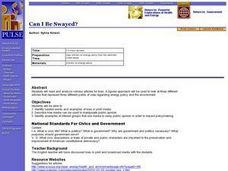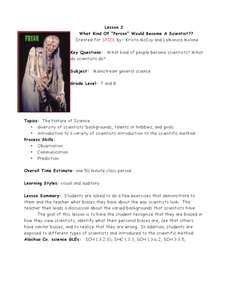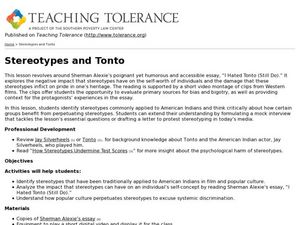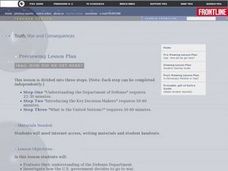Curated OER
Can I Be Swayed?
Students identify loaded words and examples of bias in print media. They describe how media can be used to manipulate public opinion. Students identify examples of interest groups that use media to sway public opinion in order to impact...
Stanford University
Vicksburg
Long before the term fake news, media outlets offered competing narratives of events at the time. Looking at newspaper reports from the Battle of Vicksburg, class members consider two different versions of the strategic siege—one from...
Curated OER
Censorship in the Classroom: Understanding Controversial Issues
Young scholars examine propaganda and media bias and explore a variety of banned and challenged books. Following this, students choose a side of the censorship issue and support their position by developing an ad campaign about the...
Curated OER
Quality of Information: Point of View and Bias
Fifth graders identify stereotypes of Indian people based on perceived characteristics. They discuss the misconceptions. Students define quality of information and give an example from the story "Seaman's Journal: On The Trail With Lewis...
Curated OER
Bias, Prejudice and Propaganda
Twelfth graders examine bias, prejudeice, and propaganda in reading selections. They view commercials and print ads, discuss how the advertisers are trying to convince them of something, and keep a commercial journal.
Curated OER
Phenomenology Lesson Plan #2: Content Part #1
Students examine different types of media. They identify the bias in film and share them with the class. They also examine their personal biases and write about them.
Facing History and Ourselves
The Audacity of a Vote: Susan B. Anthony’s Arrest
Susan B. Anthony's speech "Is It a Crime for Women to Vote?" takes center stage in a lesson that asks class members to consider how they might respond to what they consider an unjust law. Groups work through the speech paragraph by...
Curated OER
Bias
Learners apply techniques of distinguishing between fact and opinion. Students identify words associated with persuasion and argument. Learners read and categorizer a variety of newspapers and articles. Students identfy bias in a...
Education Bureau of Hong Kong
Fundamentals of Critical Thinking
Analyzing arguments is key to critical thinking. Colorful slides teach viewers how to recognize the structure of an argument, the claims, and the validity of the evidence used to support an argument. Then, provided scenarios permit...
Curated OER
What Kind of "Person" Would Become a Scientist?
"Scientist Stereotypes" could be another name for this lesson! Begin by drawing from middle schoolers' preconceived notions and media portrayal of scientists, and then explain that anyone can be a scientist. Even though there is an...
Curated OER
Media Literacy: Discovering and Understanding Propaganda
Ninth graders study different types of propaganda and select an issue that is significant to them. In this exploratory lesson students design and create posters on the topic of their choice and write a narrative describing it.
Curated OER
The Media
Students explore political advertising. They discuss what informed voters should know about upcoming elections and identify the four main types of ads and view a video to identify the types of ads. Evaluating the ads, they identify...
Curated OER
Conducting Research Online
In a day and age when publishing online has never been easier, high schoolers need to know how to identify a credible source. Choose the PowerPoint slides most relevant to your lesson and spend more time on the hands-on activities provided.
Carolina K-12
Propaganda, Spin and Soundbite Politics
It's all about the spin! In an introduction to propaganda techniques and soundbite politics, scholars first learn about common propaganda techniques before seeing them in action in the context of the 2016 election cycle. Activities...
Curated OER
Defining Moments: Analyzing Data
Students create an annotated bibliography on writings related to Japanese internment and analyze the writings for possible bias. They view a video on the Korematsu Internment case and use the internet to find print and non-print sources...
Curated OER
The Real World Revisited
Class members participate in a series of hands on, online, and multimedia activities to identify the difference between primary and secondary sources. They watch a related video and visit a variety of sites to locate primary and...
Anti-Defamation League
Student Dress Codes: What's Fair?
The controversy over school dress codes continues. The debate involves questions like, why is there a policy? Who sets the policy? Who enforces the policy? What is a fair policy? Tweens and teens have an opportunity to engage in the...
Curated OER
The Art of Persuasion-Analysis of Argument
Analyze advertising techniques in order to pinpoint persuasive strategies that writers use. These same techniques are then examined in persuasive speeches. You will have to find your own advertisements, but speeches are included. Finish...
Curated OER
Phenomenology Lesson Plan #1
Students approach media with a phenomenological criticism. They recongize biases that they have and where they have come from. They also identify biases in professional work.
Curated OER
Political Science: Political Analysis Through Satire
Students identify, analyze and explain examples of politcal satire. They discuss the role of political satire in the democratic process and create and present examples of political satire.
Curated OER
Stereotypes and Tonto
Students identify stereotypes, especially those applied to American Indians. In this teaching tolerance lesson, students read an essay entitled " I Hated Tonto (Still Do)" and discuss the negative impact that stereotypes may have on a...
Curated OER
The "Ad" Survey-What Makes a Print Ad Convincing?
Students develop opinions from a variety of materials, recognize and analyze bias, propaganda and stereotypes, and evaluate effectiveness of print advertisements.
Curated OER
Iraq: How Did We Get Here?
Students examine the role of the Department of Defense. They explain the process in which the government decides it is going to go to war with another country. They identify key decision makers and explore the role of the United Nations.
Described and Captioned Media Program
Malcolm X: Make It Plain, Part II
Track the transformation of Malcolm Little into Malcolm X and then into El Jajj Malik El-Shabazz with the second part of Make it Plain, a documentary on the famous civil rights activist. Viewers consider not only how events shaped and...

























